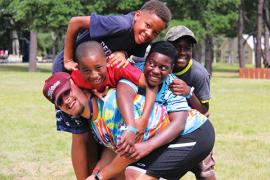When the people we love die, they leave us with treasured memories.
My father left 75 acres in Northern Wisconsin shaped by his influence: a summer camp infused with his values, rustic log cabins he preserved for posterity, and hundreds of trees he planted as saplings that now soar skyward.
My father, Bernard “Nardie” Stein, who died in late 2022 at age 91, co-directed Camp Nebagamon for Boys for three decades with my mother, Sally Lorber Stein. Dad’s front-facing role fit his genuine connection with children and young adults; quick yet kind-hearted wit; flair for song-leading; instant recall of people’s names, zip codes, and family trees; and many other competencies.
When I walk through camp, even in my imagination, I sense Dad’s presence. I have a hunch the same may be true for my family and generations of camp alumni.
The huge wooden rolltop desk still used in camp’s main office always reminds me of him. My parents realized early on that their 18-hour workdays mostly involved dealing with the unexpected. Nardie’s solution: his summer days began at 6:20 a.m. at that desk focused on routine yet important tasks. He met with maintenance staff, then joined Mom at the breakfast leadership team meeting. Nardie’s early detail wrangling freed up most of the day for creative problem-solving and the challenges and zany fun of coleading a camp community comprised of 350+ people.
Dad approached the world as if it were full of friends he just hadn’t met yet, a feeling that permeates camp. In front of Nebagamon’s main office hangs a sign, “This Shall Be a Place of Welcome for All,” translated into 33 languages so far, one panel per language. Inspired by the Civil Rights movement in the 1970s, Nardie designed the sign’s earliest panels. A panel is added each time a new language is spoken at camp. This is Nebagamon’s cultural DNA: a community dedicated to warmly welcoming newcomers who make camp better year after year.
Walk among camp’s beautiful tall trees and you’ll sense Dad’s vision of the importance of shade and erosion control on this sandy lakeside property. In 1958, 1969, 1970, and 1972, Dad led teams of staff and friends who planted hundreds of trees throughout and adjacent to camp — long rows and solo saplings of red pine, Norway spruce, and birch. Mom said she always knew when he was stressed during their years running camp, because that’s when Nardie liked to trim trees, “to raise the canopy — to help them thrive, symbolic of what he hoped to do for campers and staff.”
Nardie’s aesthetics and respect for history can be seen in the three authentic homesteaders’ log cabins he bought at auctions in the early 1960s. The largest of these was moved intact, skidded over the frozen lake. Dad turned it into a museum of lumberjacking filled with pictures and artifacts from 1898 to 1907 when Nebagamon’s site was a lumber mill run by the Weyerhaeuser family. He bought two other log cabins for $20 and $25, respectively, that were disassembled, moved, and reassembled at camp. One is a hub for older campers and their counselors, and kids learn wilderness tripping skills in the other.
After my parents retired in 1990, they built a lakeside home near camp. He loved spending time in his garage workshop decorated with his fine photography, the door open to the view of Lake Nebagamon. His specialties: repairing broken pottery and creating walking sticks, ceramic tile mosaics, cork collages, fishing lure plaques, and wooden cell phone holders.
There’s a sense of timelessness by that spring-fed lake where my maternal grandparents, Muggs and Janet Lorber, founded Camp Nebagamon in 1929. The land was previously a summer resort, a lumber mill, and home to a long lineage of the Anishinaabe people.
Dad was delighted and comforted when, in his final year, Camp Nebagamon became a nonprofit, assuring it will welcome young people for generations to come.
Jessica Stein Diamond is a freelance writer and editor, and the executive director of the Camp Nebagamon Scholarship Fund.

